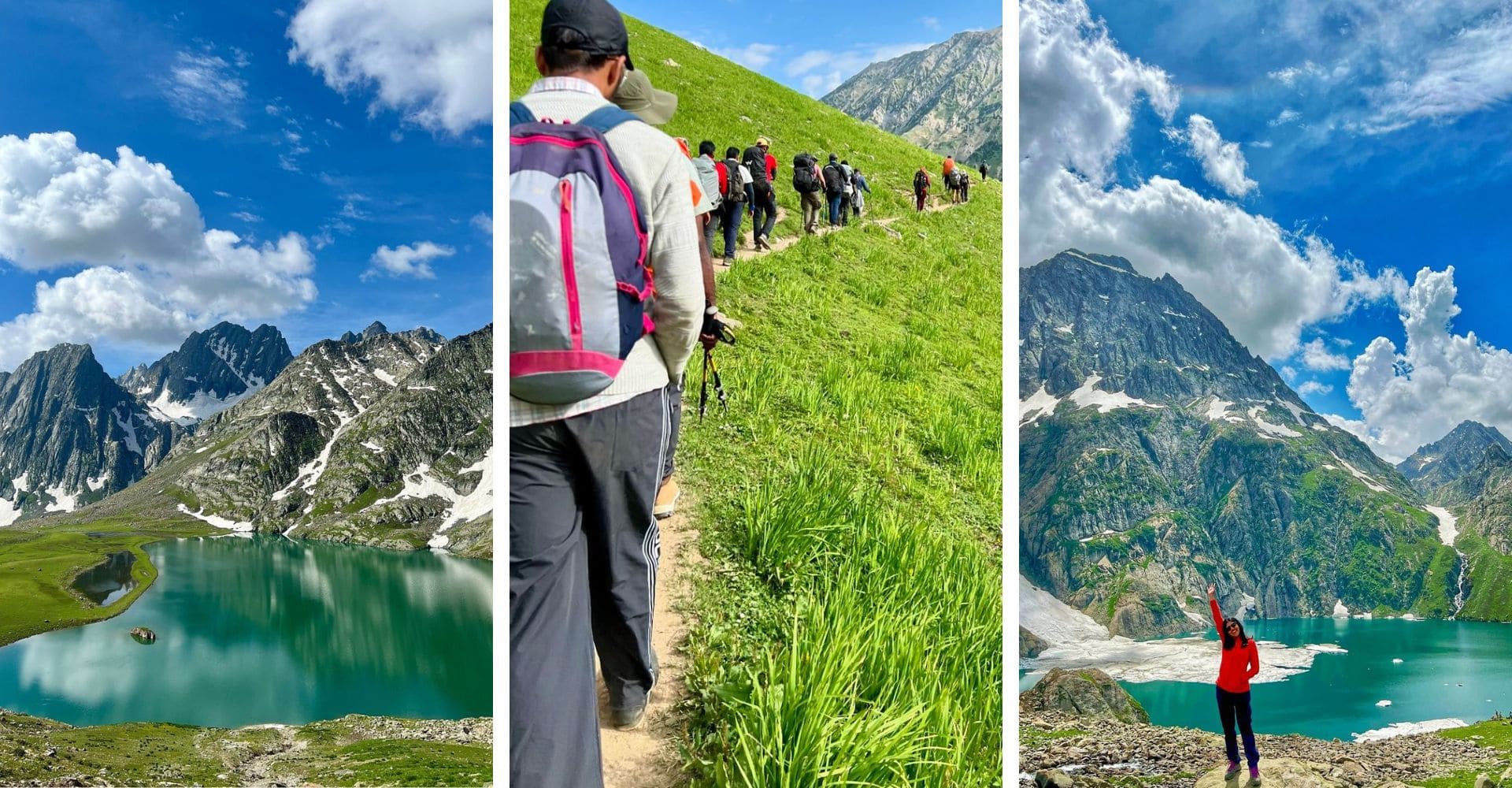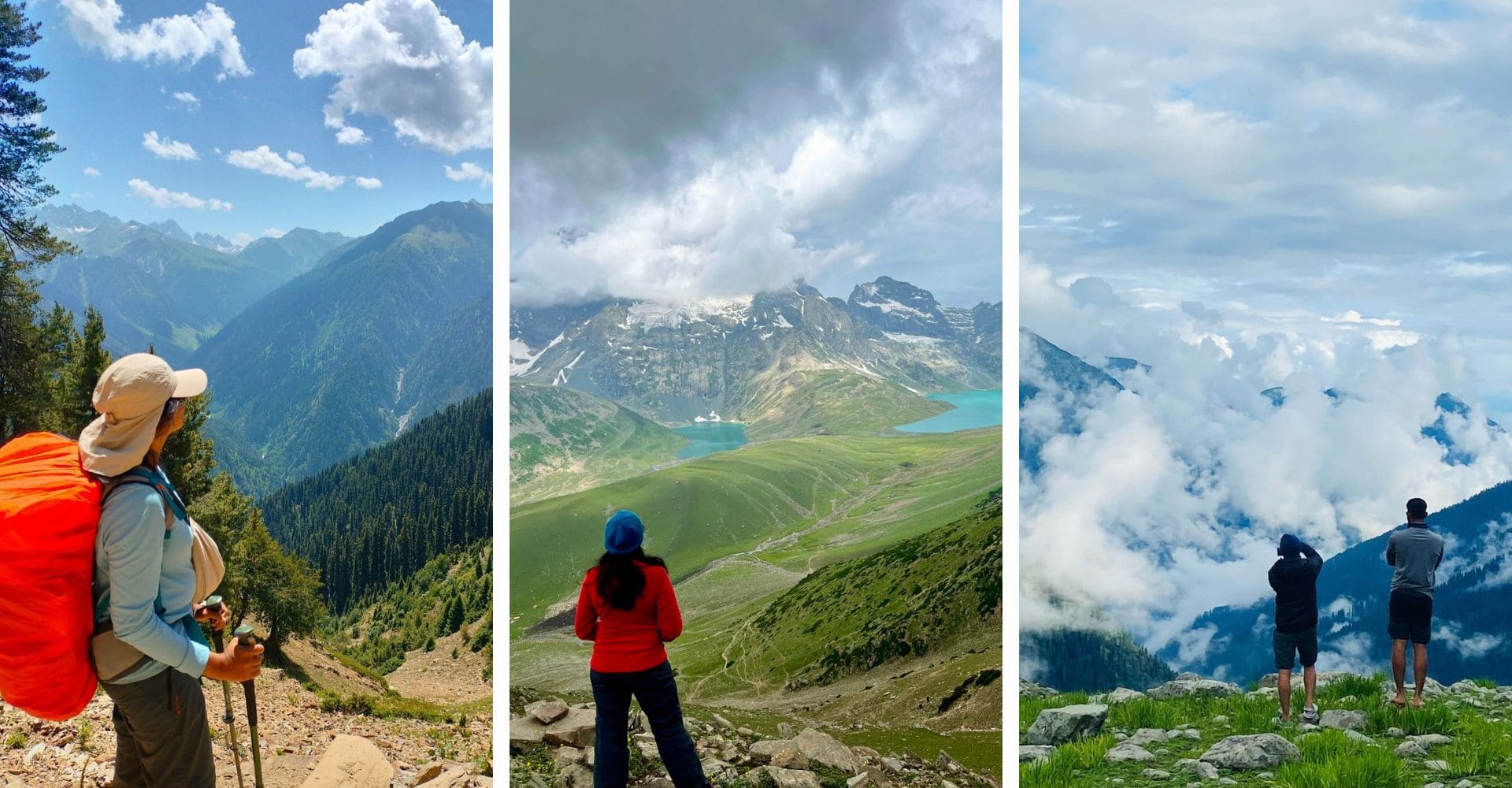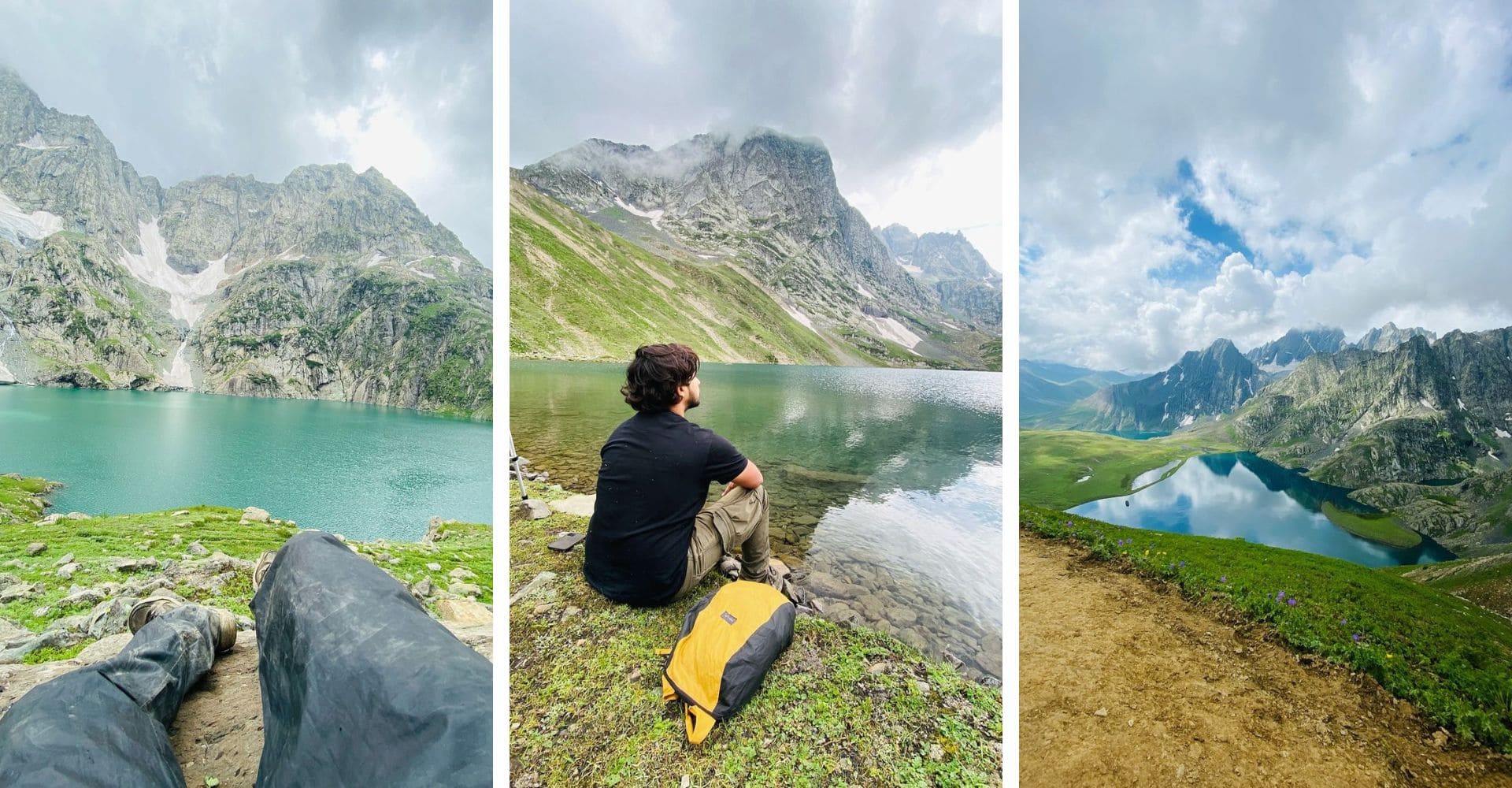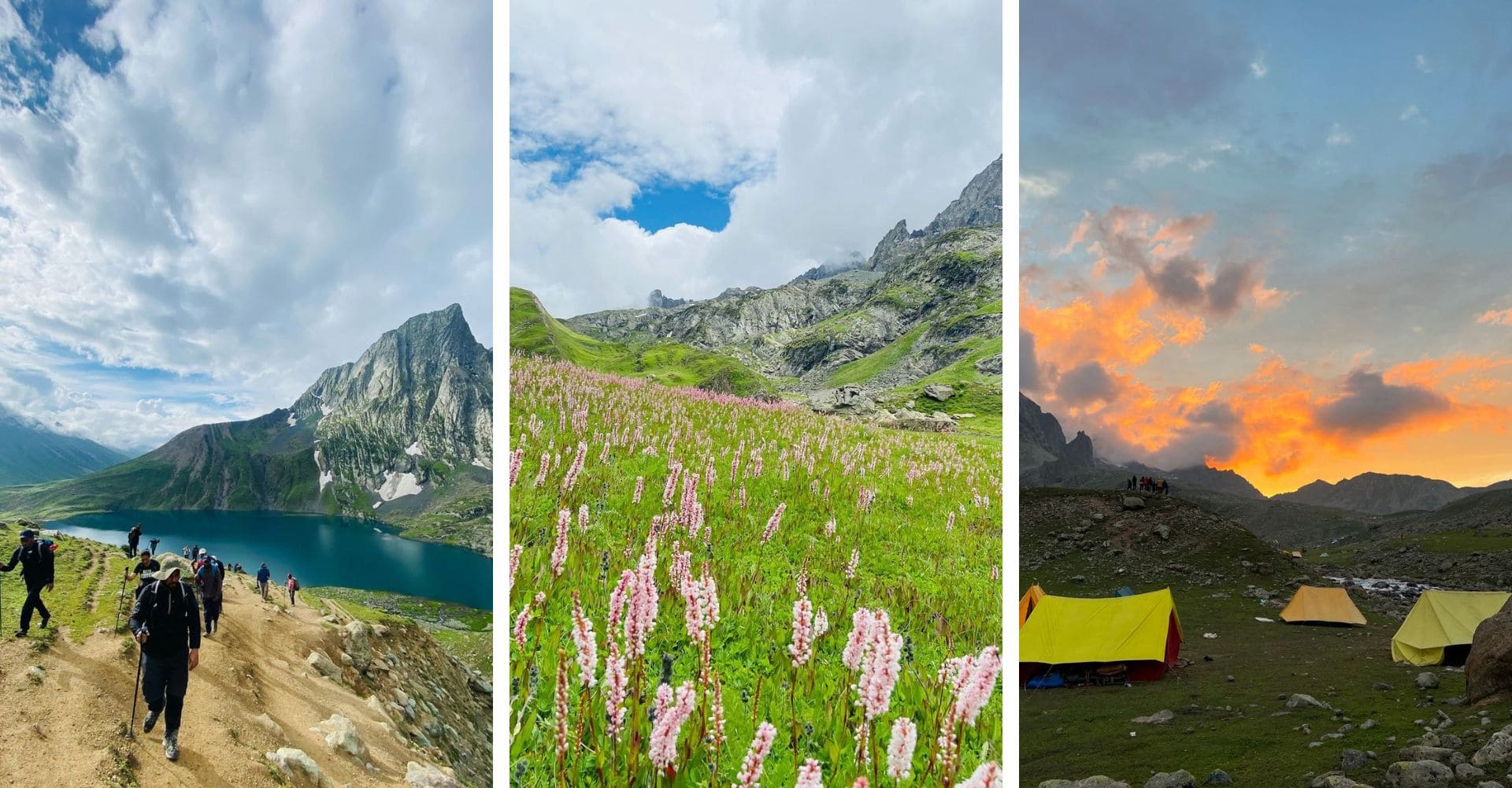



Tour Highlights
Inclusion/Exclusion
Package Cost Includes
Package Cost Excludes
Jul 2025: 1, 2, 3
Day 1: Arrival in Srinagar - Drive to Sonamarg
Pickup Time: Noon at Srinagar Airport
Drive: 76 km to Sonamarg
Duration: 4 hours
Altitude: 9,100 ft
Day 2: Shitkadi to Nichnai via Shekdur
Trek Distance: 11 km
Duration: 6 hours
Altitude Gain: From 9,100 ft to 11,500 ft
Day 3: Nichnai to Vishansar Lake
Trek Distance: 13 km
Duration: 6 hours
Altitude: 12,000 ft
Day 4: Vishansar Lake to Gadsar Lake
Trek Distance: 16 km
Duration: 5 hours
Altitude Gain: 13,750 ft
Weather Conditions: Cool with strong winds at the pass.
Day 5: Gadsar Lake to Satsar Lake
Trek Distance: 12 km
Duration: 6 hours
Altitude: 12,000 ft
Day 6: Satsar Lake to Gangbal Twin Lakes
Trek Distance: 9 km
Duration: 6 hours
Altitude: 11,500 ft
Day 7: Gangbal to Naranag - Drive to Srinagar
Trek Distance: 13 km
Duration: 6 hours
Altitude Decrease: 7,450 ft
Kashmir Great Lakes Trek Overview
Nestled in the heart of the Kashmir Valley, the Kashmir Great Lakes Trek is a fascinating journey that stretches across some of Indias most beautiful alpine landscapes. Stretching over 70 km, the trek lies at an altitude of 7,500 to 13,750 feet, offering a moderate challenge that is worth the effort for its unparalleled natural beauty.
Starting from Sonamarg, a quaint town located at an altitude of around 7,800 feet, the trek takes you through a variety of terrains – from lush green meadows and dense forests to high-altitude lakes and rocky terrains. The trek is ideally undertaken between July and September, when the snow melts, and the meadows are in full bloom with a vibrant hue of wildflowers.
The KGL trek is a visual treat and a cultural journey. As you travel through remote Himalayan landscapes, you come across shepherd huts and get a glimpse of the nomadic lifestyle of the Gujjars and Bakarwals, adding a rich cultural layer to your adventure. The lakes, each of which has a unique story and mythology, provide a sense of spiritual peace that lingers long after the trek.
History and Mythological Significance
The Kashmir Great Lakes found in the Himalayas of Jammu and Kashmir India, are high-mountain lakes famous for their looks and cultural value. Lets explore the history and legends of some important lakes:
Gadsar Lake
Vishansar and Krishansar Lakes
Gangbal Lake
Dal Lake
Satsar Lake
Flora and Fauna of the Kashmir Great Lakes Trek
The treks ecosystem is incredibly diverse, showcasing the rich flora and fauna of the Kashmir Himalayas. The meadows are dotted with a variety of wildflowers like blue poppies, daisies, and asters, providing a colorful canvas against the stark white of the snow-capped peaks. The dense forests are home to Himalayan marmots, brown bears, and a wide array of bird species, making it a paradise for nature enthusiasts and birdwatchers.
About the Lakes of Kashmir Great Lakes Trek
Each lake along the Kashmir Great Lakes Trek holds its unique charm:
Kashmir Great Lakes Trek Best Time
The Kashmir Great Lakes Trek is best done from June to September when the trails are most accessible and the scenery is at its peak beauty. These months offer clear skies, pleasant weather, and breathtaking views, making them ideal for trekkers.
June to August: The Ideal Trekking Season
The months from June to August are considered the best time to undertake the Kashmir Great Lakes Trek. During this period, the weather is relatively mild, with daytime temperatures ranging from 15°C to 20°C (59°F to 68°F) and nighttime temperatures staying above 0°C (32°F). This season provides the most stable weather and vibrant landscapes.
Late August to September: A Mix of Beauty and Challenges
The late monsoon season, from late August to September, offers a unique trekking experience with lush green landscapes and full lakes. Daytime temperatures range from 10°C to 15°C (50°F to 59°F), with cooler nights.
October: A Tranquil and Crisp Adventure
October offers cool and crisp conditions, with daytime temperatures between 5°C to 10°C (41°F to 50°F) and colder nights. This is the perfect season for those who enjoy a quieter trekking environment.
Why Avoid the Monsoon and Winter Months?
Kashmir Great Lakes Trek Trek Level of Difficulty
The Kashmir Great Lakes (KGL) trek is moderate to challenging, and suitable for those with some high-altitude trekking experience. It covers varied terrains, including steep ascents, rocky trails, meadows, and river crossings. Difficulty varies daily, requiring stamina and good acclimatization. Challenging parts include narrow cliff-edge paths and steep climbs, especially near Gadsar Pass. Unpredictable weather adds complexity, but preparation makes it rewarding.
Trail Conditions
Trails vary by season and altitude. Summer (June-September) offers clear paths, with some snow at higher altitudes. Monsoon season brings slippery conditions. Winter is usually inaccessible. Trails are narrow with steep sections, requiring careful movement.
Daily Trek Distance
Daily distances range from 8-12 kilometers, with varying difficulty. The Gadsar Pass ascent is typically the most strenuous. Maintain a steady pace and stay hydrated.
Elevation and Altitude Gains
The trek starts at 7,800 feet, reaching 13,800 feet at Gadsar Pass. Ascent is gradual, but the Gadsar Pass climb is challenging. Altitude-related symptoms may occur.
Weather Conditions
Weather on the Kashmir Great Lakes trek varies by season and altitude. Summers are mild with cool nights, but higher altitudes can bring sudden changes. Monsoons make the trek slippery and challenging. Winters are harsh with sub-zero temperatures, making the trek inaccessible. Be prepared for all conditions.
Physical Fitness Requirements
The trek demands good fitness due to its challenging nature and high altitude. Prepare for long days of trekking with steep ascents and descents while carrying a backpack. Cardiovascular fitness, strength, and stamina are crucial. Regular exercise, including cardio and hiking, is recommended before the trek.
How to Reach Kashmir Great Lakes Trek Pick-Up Point: Srinagar
The Kashmir Great Lakes trek typically starts from Sonamarg, a picturesque town located in the Ganderbal district of Jammu and Kashmir.
Reaching Srinagar (Pick-Up Point)
Departure from Sonamarg
By preparing well, understanding the trail conditions, and knowing the weather patterns, trekkers can enjoy the unique and stunning experience of the Kashmir Great Lakes trek.
Kashmir Great Lakes Itinerary
Day 1: Arrival in Srinagar - Drive to Sonamarg
Pickup Time: Noon at Srinagar Airport
Drive: 76 km to Sonamarg
Duration: 4 hours
Altitude: 9,100 ft
Weather Conditions: Cool and pleasant during the day; chilly at night.
The journey begins with excitement as trekkers arrive at Srinagar Airport, eagerly anticipating the adventure ahead. The drive to Sonamarg is a visual treat, offering glimpses of Kashmirs vibrant countryside. Rolling green valleys dotted with colorful flowers and quaint villages greet you along the way. On reaching Sonamarg, you are enveloped by the tranquility of the “Meadow of Gold,” with towering peaks in the background. After a day of scenic delight, you settle into cozy camps or guesthouses, sharing stories and building camaraderie over a hearty dinner.
The drive to Sonamarg was the perfect prelude to the trek – calm, serene, and beautiful.
Day 2: Shitkadi to Nichnai via Shekdur
Trek Distance: 11 km
Duration: 6 hours
Altitude Gain: From 9,100 ft to 11,500 ft
Weather Conditions: Mild during the day; cold and windy at night.
The trek officially begins from Shitkadi, where you step into an enchanting world of tall pine forests. As you walk, the air is filled with the sweet scent of cedarwood, and the trail winds through dense forests and scenic clearings.
A brief stop at the meadows of Shekdur provides a panoramic view of the Himalayas—a photographers dream. The path ascends towards Nichnai, with the sound of the river guiding you. As you reach the campsite, the breathtaking sight of lush green meadows welcomes you. Relax and recharge for the night amidst natures serene embrace.
Crossing Shekdur felt like walking into a painting – the contrast of deep green against the distant snowy peaks was surreal.
Day 3: Nichnai to Vishansar Lake
Trek Distance: 13 km
Duration: 6 hours
Altitude: 12,000 ft
Weather Conditions: Pleasant during the day; cold winds at night.
Today, the trail takes you through the Nichnai Pass, or the "Shepherds Pass," known for its breathtaking beauty. As you trek through lush meadows and babbling brooks, you surrounded by stunning wildflowers and mountain peaks.
Reaching the Nichnai Pass offers a spectacular view of the snow-clad peaks stretching out into the horizon. After crossing the pass, you descend towards the serene Vishansar Lake, whose clear blue waters reflect the sky. The campsite here is picturesque, surrounded by greenery, with the lakes tranquil presence setting the mood for a restful night.
Day 4: Vishansar Lake to Gadsar Lake
Trek Distance: 16 km
Duration: 5 hours
Altitude Gain: 13,750 ft
Weather Conditions: Cool with strong winds at the pass.
An early morning start brings an unforgettable experience—catching the first light over Vishansar Lake, turning the waters into a shimmering sheet of gold. Today journey is both challenging and exhilarating as you traverse rocky terrains, pass Kishansar Lake, and ascend towards the Gadsar Pass, the treks highest point.
The breathtaking views from the past make the climb worth it, offering glimpses of multiple lakes. A steep descent brings you to Gadsar Lake, known as the “Lake of Flowers,” where you camp amid vibrant meadows.
Reaching Gadsar Pass felt like touching the sky; the views were panoramic and awe-inspiring.
Day 5: Gadsar Lake to Satsar Lake
Trek Distance: 12 km
Duration: 6 hours
Altitude: 12,000 ft
Weather Conditions: Mild and pleasant with cool breezes.
Leaving Gadsar behind, the trail today is comparatively gentle, taking you through lush green meadows and across small streams. The path leads to Satsar Lake, a cluster of seven interconnected lakes, each more beautiful than the last. The campsite at Satsar is a serene spot where trekkers often reflect on the journey while basking in the beauty of the surrounding landscape.
Walking to Satsar felt like being in a fairy tale; every turn presented another picturesque lake or blooming flower bed.
Day 6: Satsar Lake to Gangbal Twin Lakes
Trek Distance: 9 km
Duration: 6 hours
Altitude: 11,500 ft
Weather Conditions: Cool with occasional light showers.
Today, the trek leads through rocky terrain, where the path offers both challenges and breathtaking views. The sight of the Gangbal Twin Lakes – Nandkol and Gangbal – nestled under Mount Harmukh, is a visual feast. These sacred lakes are surrounded by alpine meadows and offer a serene ambiance, perfect for unwinding and soaking in the majestic views.
The descent to Gangbal was mesmerizing; the twin lakes shimmered like two blue jewels amid the vast wilderness.”
Day 7: Gangbal to Naranag - Drive to Srinagar
Trek Distance: 13 km
Duration: 6 hours
Altitude Decrease: 7,450 ft
Weather Conditions: Pleasant in the morning; warm in Naranag.
On the final day, trekkers begin their descent from Gangbal to the village of Naranag. The path winds through pine forests, offering a meditative journey down the mountain. As you arrive in Naranag, ancient temple ruins greet you, a silent witness to centuries of history. A scenic drive back to Srinagar marks the end of this incredible journey.
The descent through the pine forests was peaceful, a perfect way to end this breathtaking trek.”
Why Choose Our Kashmir Great Lakes Trek Package?
Kashmir Great Lakes Trek: Essentials
Trekking is undoubtedly one of the most thrilling adventures one can experience. With the breathtaking beauty of nature and the unparalleled charm of pristine mountain ranges, trekking stands out as a unique adventure worldwide. However, every great experience comes with its own set of responsibilities. Before embarking on a trek, there are certain important aspects to consider. Here a list of essential items and requirements to keep in mind for a successful trekking experience. Lets take a closer look at these trekking prerequisites.
Things You Can not Afford Missing On Trek
1. Backpack/RukSack
A high-quality backpack with sturdy, durable straps and a comfortable carrying design is essential for any trekking adventure. The more comfortable it is to carry, the more enjoyable your trek will be.
2. Trekking Shoes
Regular sports shoes can be problematic on a trek and may end up diminishing your experience. To navigate slippery patches and stream crossings safely, invest in a pair of trekking shoes with excellent grip. They will not only keep you steady but also significantly enhance your overall trekking experience.
Clothing
Choosing the right clothing is crucial for trekking, but there is no need to overpack for what-if scenarios. Stick to the essentials and carry only what you will typically need. Overpacking will only add unnecessary weight, making the trek more challenging. During the trek, frequent clothing changes are usually unnecessary as long as you maintain proper hygiene.
Three Warm Layers Jacket
At high altitudes, temperatures can drop significantly after sunset. To stay warm at campsites, it essential to have an additional layer, such as a padded jacket, paired with a fleece and thermal wear.
Trek Pants
Avoid wearing jeans or denim as a substitute for trek pants, as they are not comfortable for trekking or staying at campsites. Instead, wear one pair of trek pants and carry two additional pairs.
T-Shirts
Wearing full-sleeved t-shirts is recommended to protect yourself from sunburn. If you are trekking during the rainy season, carrying one or two dry-fit t-shirts can be a smart choice. Despite the cold weather, trekking often causes sweating, so its important to change into fresh clothes at campsites to avoid falling ill.
Warmers
Warmers or thermals can be included based on individual health needs and sensitivity to cold climates.
Accessories
Sunglasses
Sunglasses are essential for preventing snow blindness. Although you are unlikely to encounter snow in October, it still a good idea to carry a pair just in case.
Sun Cap
The sun feels more intense when trekking on mountain slopes. Carry a sun hat to protect your head and neck from the heat, especially if you are trekking later in the day.
Hand Gloves
A pair of fleece or woolen gloves and a pair of waterproof, windproof gloves.
Balaclava
You may utilize woolen scarves rather too.
Socks
In addition to two pairs of sports socks, bring a couple of woolen socks for the night to keep your feet warm in cold temperatures.
Headlamp / Tourch
Trekking Stick
Using a trekking pole during a trek can be a blessing. While it might occasionally feel like an unnecessary item, it becomes incredibly useful, especially during steep ascents. It significantly reduces the effort required to tackle the challenging inclines of high altitudes, which can otherwise be quite exhausting.
Other Essentials to Carry
Carrying an additional lightweight pack is a great practice for one-day summits or treks where you return to your campsite by the end of the day. Use this pack to carry essentials like a water bottle, first aid kit, and snacks. It helps you avoid the burden of carrying unnecessary weight.
Toiletries
Choose your cosmetic and daily-use products wisely, prioritizing biodegradable options. If you must use non-biodegradable items, ensure you do not leave any residue on the mountains. Always carry a zip bag to store such waste after use. The same approach applies to sanitary napkins, which should also be responsibly disposed of.
Water Bottles
To stay hydrated during your trek, it essential to carry your own water bottles. Avoid using disposable plastic bottles, as leaving plastic waste in the mountains harms the fragile high-altitude environment.
Plastic Bags
To stay organized, compartmentalize your items into plastic zip bags and carry a few extras for wet clothes and other waste items.
Mandatory Documentation
When embarking on a trek, there are specific rules and regulations you must follow. The Mountain Trekker handles all the necessary paperwork as part of the package. This includes registration fees, document verification, and obtaining required permissions to help preserve nature and its timeless heritage.
If you wish to hire a guide, you can do so for an additional fee along with minimal paperwork.
Required Documents:
Please bring the following documents. Items 2 and 3 must be downloaded (PDF format), completed, signed, and submitted to the trek leader at the base camp:
Measures Taken by The Mountain Trekker to Ensure the Security of Trekkers
Trekking is a unique adventure that requires both physical and mental preparation to handle the best and the worst situations. High altitudes can make breathing challenging, while the breathtaking scenery of pristine mountains can momentarily leave you spellbound. Alongside physical and mental readiness, several health considerations must be addressed before embarking on a trek.
The Mountain Trekker, with its team of trained professionals, leaves no stone unturned to provide the best trekking experience while prioritizing safety. Here are the key measures The Mountain Trekker implements to ensure the security of its trekkers:
Fitness Assessment
Trekking at high altitudes requires endurance and fitness. Individuals with physical or physiological ailments are advised against high-altitude treks initially. To ensure trekkers’ safety, we evaluate fitness levels by checking parameters such as Body Mass Index (BMI) and requiring fitness certification. This minimizes risks during the trek.
Acclimatization is crucial for adapting to high-altitude climates. A designated rest day allows trekkers to adjust to the environment and its conditions.
Health monitoring is conducted regularly during the trek by trek leaders. This includes checking blood pressure, oxygen levels, and pulse rate, with all details recorded in a health card. Trekkers can collect their health card from the trek leader at the end of the trek.
Medical Kit for High-Altitude Trekking
The Mountain Trekker equips its medical kits with essential tools and medications to address high-altitude emergencies. These include:
Blood Pressure Monitor
Pulse Oximeter
Oxygen Cylinder
Essential medicines, such as: Diamox, Dexamethasone, Nifedipine, Asthalin Inhaler, Syringes
Trekking Equipment for High Altitudes
The Mountain Trekker provides all necessary trekking equipment, from tents to ropes, ensuring a safe journey. Additional safety measures include:
Microspikes: Attach to shoes for better traction on snow.
Gaiters: Prevent snow from entering shoes.
Customized Tents: Offer warmth and maintain temperatures 10°C higher than the outside.
High-Quality Sleeping Bags: Withstand temperatures up to ?15°C.
Nutrition and Hydration
The Mountain Trekker emphasizes proper nutrition and hydration, crucial for high-altitude treks. Trek leaders guide trekkers to maintain hydration, as dehydration can lead to severe health issues.
Trekkers are provided with highly nutritious meals to sustain energy levels. Before long trails, additional high-energy snacks or packaged lunches are offered. Trekkers are advised to report any symptoms promptly to trek leaders.
Handling Medical Emergencies: AMS, HAPE, and HACE
The Mountain Trekker trained professionals are equipped to handle medical emergencies, including Acute Mountain Sickness (AMS), High Altitude Pulmonary Edema (HAPE), and High Altitude Cerebral Edema (HACE).
AMS Symptoms: Persistent headache, fatigue, nausea, dizziness, loss of appetite, and difficulty sleeping. These should be reported immediately to trek leaders. AMS, if untreated, can lead to severe conditions like HAPE or HACE.
Treatment: Medications such as Diamox and Nifedipine are administered along with methods like the Triple One Test (one aspirin, one liter of water, and one hour of rest).
HAPE and HACE: These conditions can occur independently of AMS and require immediate medical attention. Trained trek leaders ensure appropriate responses, including descent to base camp and evacuation if necessary.
Risk and Response
High-altitude trekking involves inherent risks. The Mountain Trekker has documented potential risks and corresponding responses to ensure safety:
Risk: Altitude
High altitudes can cause AMS, leading to headaches, nausea, and discomfort.
Response: Trek leaders monitor symptoms and provide medical aid, including oxygen support and medication. Stretcher evacuation is available if needed.
Risk: Weather
Himalayan weather is unpredictable, with sudden snowfalls or rain.
Response: Trek leaders make final decisions on continuing or pausing treks based on weather conditions to ensure safety.
Risk: Injuries
Trekkers may experience minor injuries like sprains or bruises, with serious injuries being rare.
Response: Certified Wilderness First Aid responders handle minor injuries. Serious cases involve stretcher evacuation to the nearest medical facility.
Risk: Lack of Communication
Remote Himalayan areas often lack mobile network coverage.
Response: Communication between base camps and trek leaders relies on walkie-talkies and runners.
By adhering to these processes and guidelines, The Mountain Trekker ensures a safe and memorable trekking experience for all participants.
Tour Payment Terms
Initial amount of 25% of the Invoice amount, the Client must pay the balance amount 3 days prior to the date of departure of the Tour.
Tour Cancellations Policy
If the Client is willing to amend or cancel his/her booking because of whatsoever reasons including death, accident, illness, or any other personal reasons including non-payment of the balance payment, the Company is liable to recover Cancellation charges from the Client, as company had already paid your amount in advance in order to Guarantee your services.
To read more payment and cancellation policy Click Here
1. What is the Kashmir Great Lakes Trek?
The Kashmir Great Lakes Trek is a breathtaking trekking expedition in the Himalayas, located in the Indian state of Jammu and Kashmir. The trek takes you through some of the most stunning landscapes, including alpine meadows, snow-capped mountains, and pristine glacial lakes like Vishansar, Krishansar, Gadsar, Satsar, and Gangbal.
2. What is the best time to do the Kashmir Great Lakes Trek?
The best time to do the Kashmir Great Lakes trek is from mid-June to mid-September. During this period, the weather is generally pleasant, the skies are clear and the temperature is moderate, which is ideal for trekking. The grasslands are in full bloom and the lakes are thawed, offering spectacular views and a wonderful experience.
3. What is the duration and difficulty of the Kashmir Great Lakes trek?
The Kashmir Great Lakes trek usually lasts for 7 to 8 days, depending on the route and pace of the trekking group. The trek usually starts from Shitkadi near Sonamarg and ends at Naranag, covering a distance of about 70-75 km. It involves walking for 6-8 hours daily across varied terrain, including steep ascents and descents, rocky paths, and river crossings.
4. Are permits required for the Kashmir Great Lakes trek?
Yes, permits are required for the Kashmir Great Lakes trek as it passes through protected areas and Indian Army checkpoints. These permits can be obtained in Srinagar or through our trekking organizer, who will arrange all the necessary paperwork on your behalf.
5. What kind of accommodation is available on the trek?
Accommodation on the Kashmir Great Lakes trek is usually in tents. Campsites are located at scenic spots such as Sonamarg, Nichnai, Vishansar Lake, Gadsar Lake, Satsar Lake, and Gangbal.
6. Is it safe to do the Kashmir Great Lakes trek?
Yes, the Kashmir Great Lakes trek is generally safe for trekkers.
7. What is the maximum altitude reached during the Kashmir Great Lakes trek?
The maximum altitude reached on the Kashmir Great Lakes trek is about 4,180 m (13,715 ft) at the Gadsar Pass.
8. Is there any mobile network available on the Kashmir Great Lakes trek?
Mobile network coverage is limited on the Kashmir Great Lakes trek. You may get connectivity intermittently near Sonamarg and Naranag, but there will be no network access on most of the trek routes. It is advisable to inform family and friends about the lack of connectivity in advance.
9. What kind of food is provided during the trek?
During the Kashmir Great Lakes trek, vegetarian food is usually provided by the trek organizers. The food usually includes breakfast, packed lunch, evening tea, and dinner. The food is simple but nutritious, fulfilling the energy requirements of trekkers.
10. Are there any altitude-related problems on the Kashmir Great Lakes Trek?
This trek involves a lot of altitude, and some trekkers may experience symptoms of altitude sickness such as headaches, nausea, or dizziness. It is important to acclimatize properly, stay hydrated, and take necessary precautions such as not climbing too quickly.
Want A Detailed Itinerary?